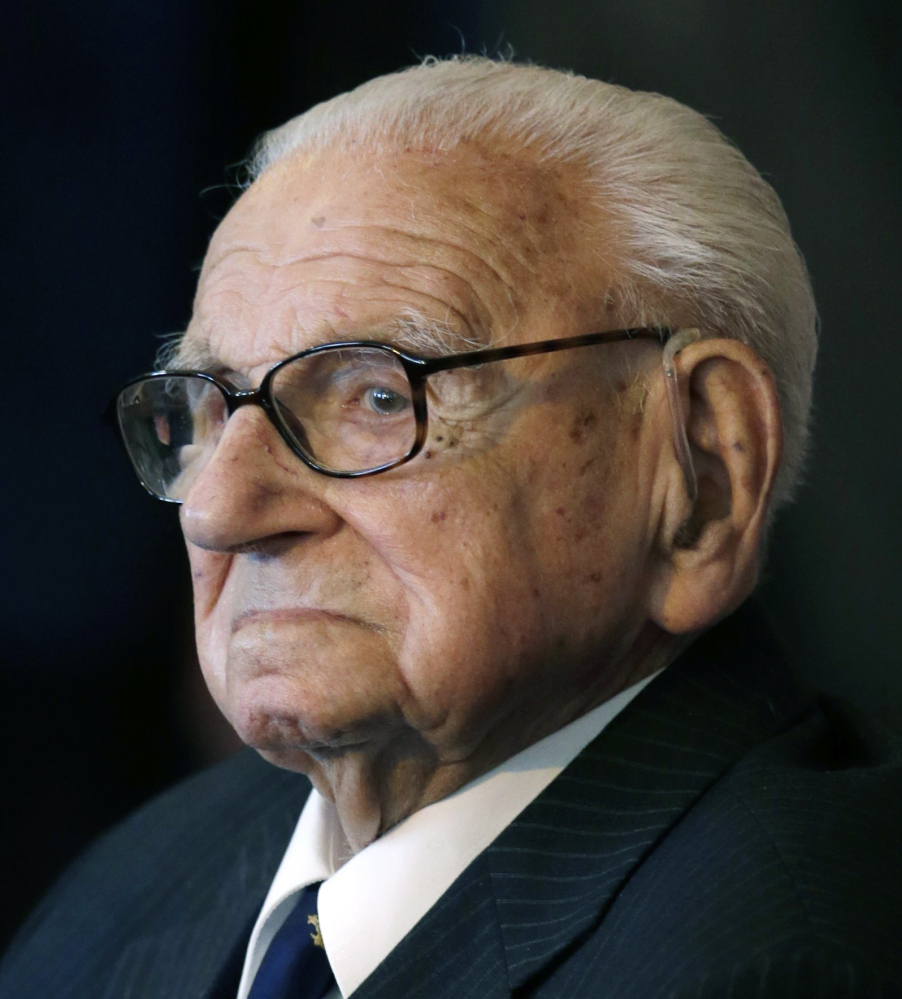“Who’s helping the children?”
That was the question that Nicholas Winton, a 29-year-old English stockbroker, asked when he found himself in Prague in 1938. As war loomed in Europe, humanitarian groups had initiated efforts to aid Jews, political refugees and other groups endangered by Hitler’s advancing threat. But Winton found no such effort underway specifically for the children of Czechoslovakia.
Inspired by the Kindertransport, a rescue operation then in place for children in Germany and Nazi-occupied Austria, Winton set about a mission he called his “wartime gesture.” He was credited with saving, through his personal initiative, the lives of at least 669 boys and girls. For decades after the war, he kept his work secret.
By the time of his death on July 1 at 106, Winton was internationally celebrated as a hero of the Holocaust. He appeared uncomfortable with the honors bestowed on him, which included a knighthood from Queen Elizabeth II, and remarked that the work accounted for “just nine months in a very long life.”
Those nine months began in December 1938. By that time, European powers had signed the Munich Agreement, which allowed Nazi Germany to annex the Czech area known as the Sudetenland. British Prime Minister Neville Chamberlain predicted that the agreement would bring “peace for our time.”
SKIING VACATION THAT NEVER WAS
Winton was preparing for a ski trip when he received a call from his travel companion, Martin Blake.
“The skiing’s off,” Winton later recalled his friend saying. “I am off to Prague instead. I have a most interesting assignment and I need your help. Come as soon as you can. And don’t bother bringing your skis.”
Blake, a schoolteacher, was associated with the British Committee for Refugees from Czechoslovakia, an organization created to assist Jews and other targets of Nazi persecution who left the Sudetenland after the German occupation.
“I called myself Honorary Secretary of the Children’s Section of the British Committee for Refugees from Czechoslovakia,” Winton told The Washington Post in 1989. “The other people,” he added, referring to government bureaucrats and others confronted with his doggedness, “they just called me a bloody nuisance.”
Winton occupied a hotel room in Prague’s Wenceslas Square and later an office where, over several weeks, he collected applications from parents seeking a way out of Czechoslovakia for their children. Thousands of families lined up outside his door, according to an account by the U.S. Holocaust Memorial Museum.
HEARTBREAKING CHOICES
“Each group felt that they were the most urgent,” Winton told the London Daily Mail. “How could I, or anyone else in London, choose the most urgent cases? Often it was heartbreaking.”
With the applications in hand, Winton returned to England and began seeking host families for the children. He wrote letters to government leaders around the world, including in the United States. Nearly all of them turned down his requests for assistance. “If America had only agreed to take them, too,” he said, “I could have saved at least 2,000 more.”
Sweden agreed to take in some of the young refugees, as did Britain – provided that Winton could identify families willing to care for the children until they were 17 years old. The government also required that he secure the staggering sum of 50 pounds per child for their eventual return home.
Many of the children would lose their parents in the Nazi death camps and had no home to return to after the war.
While holding down his job at the stock exchange and with help from assistants, including his mother, Winton gathered or forged travel documents for the children, raised the necessary funds and recruited host families through newspaper advertisements and other means.
In Czechoslovakia, he had the foresight to photograph the children looking for homes. To prospective host families, those haunting images proved more compelling than a list of names.
“It was a nasty, commercial way of doing things,” Winton told an interviewer years later, “but it was effective.”
The host families came from Jewish, Christian and other religious backgrounds. Decades after the war, Winton recalled the resistance he encountered from some rabbis, who perhaps at that time did not yet fully realize the degree of danger facing the Jews of Europe.
“One day, a couple of rabbis arrived at my home and said that they understood that some of the good Jewish children whom I was bringing over to this country were going to Christian homes,” he told the London Daily Telegraph. “And that must stop, they told me. And I said: ‘Well, it won’t stop. If you prefer a dead Jew in Prague to a live one who is being brought up in a Christian home, that is your problem, not mine.'”
The first group left Prague by air on March 14, 1939, one day before Nazi Germany invaded the Czech areas of Bohemia and Moravia. Seven subsequent transports – the last of them departed Aug. 2, 1939 – carried the children by train through Europe and then by ship across the English Channel.
Copy the Story LinkSend questions/comments to the editors.



Success. Please wait for the page to reload. If the page does not reload within 5 seconds, please refresh the page.
Enter your email and password to access comments.
Hi, to comment on stories you must . This profile is in addition to your subscription and website login.
Already have a commenting profile? .
Invalid username/password.
Please check your email to confirm and complete your registration.
Only subscribers are eligible to post comments. Please subscribe or login first for digital access. Here’s why.
Use the form below to reset your password. When you've submitted your account email, we will send an email with a reset code.